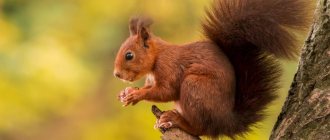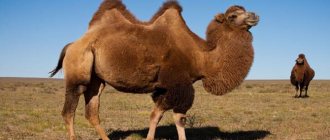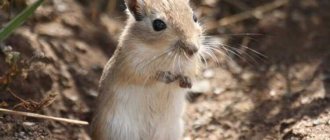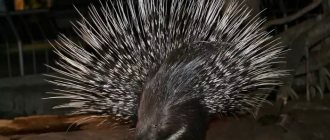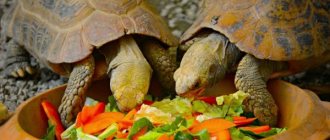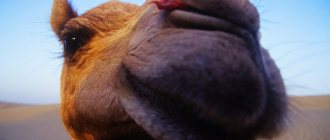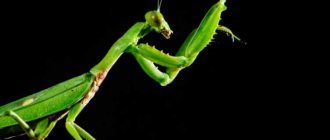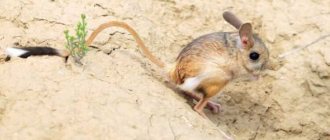Review author: “ZooVita”
Small, inconspicuous striped lumps are a decoration of the forests of central Russia and the Siberian taiga. According to scientists, chipmunks are distributed throughout the planet. The scientific name of the genus of these animals “Tamias” means thrift, thrift. The literal translation is “household manager.”
The description of the chipmunk just says that the animals hide seeds, berries, and nuts in their holes, stocking up on food in the summer and autumn in order to fully survive the winter. Chipmunks are also capable of stuffing their cheek pouches with nuts and grain, which makes them unique creatures of the fauna world.
Types of chipmunks
The photo of chipmunks shows individuals of several varieties of these animals. In total, scientists count about a quarter of a hundred types of minke whales. The Asian and Siberian species of chipmunks lives in Russia. The remaining 23 are residents of the North American continent.
Popular message topics
- Elephant
Currently, there are 3 types of these incredible creatures: forest and savanna elephants belonging to the African genus, and Asian elephants. It is quite easy to distinguish them from each other; the largest is the African savannah elephant. - Use of electricity
Electricity plays the biggest role in human life. It would seem today that it is very difficult to imagine a family that would give up TV, light and small household appliances. We are so accustomed to comfort that we can hardly imagine life without - The works of Mark Twain
The name of the American writer Mark Twain is well known to both children and adults thanks to the inimitable humor of his works.
Chipmunk sizes
These are small animals, weighing hundreds of grams. Height, depending on the species, is from 5 to 15 cm. All animals, without exception, have a beautiful, fluffy tail. Its length can reach up to 10 cm.
Chipmunk appearance
These animals have fluffy skins. There are also characteristic longitudinal black stripes on the back and slightly on the sides. They alternate with gray and white stripes. The rest of the body is covered with brownish fur. In winter, the fur is thicker, and by summer the animals molt. Some individuals have light, almost white fur, but scientists do not classify them as albinos.
Chipmunks look a little like squirrels, but are much smaller and have completely different eye structures. Therefore, scientists have clearly differentiated these species. Male chipmunks are much larger than female chipmunks.
Chipmunks stuff food into their cheek pouches. These are quite curious animals. They monitor what is happening with their small eyes, similar to almonds. Chipmunks have small, round ears. The hind limbs are longer than the forelimbs.
Meet the taiga chipmunk
Along with the plant world, people often come into contact with animals. A gift from nature will be the opportunity to see and observe taiga birds: capercaillie, black grouse. Of the predators, the most likely encounter is a bear, which you need to beware of.
Nevertheless, the taiga is a beautiful place and it is impossible to resist the temptation to wander through it and collect its tasty and healthy gifts.
Those who are new to the taiga will be surprised by the chipmunk. This cute little animal does not run away, minds its own business, looking at people with interest.
If you don’t make any sudden movements, and also lightly throw something tasty to him - bread, a nut, then the little fluffy creature will get very close to the “new acquaintance”.
Little cheerful balls - the decoration of the taiga - move very gracefully and are quite sociable for wild animals.
Note!
Chinchilla at home - description, color, character, features and conditions of detention. All the pros and cons of maintaining a house + reviews
Marmots - life features, interesting facts, habitat, photos, enemies, population
- The gerbil is a representative of rodents, features, habitat, diet, interesting facts + photos
Chipmunk habitats
Most species live in North America. The Russian range extends across the expanses of the Urals, the Far East, and Siberia. Chipmunks have been spotted on one of the Chinese islands, as well as in Korea. Residents of Northern European countries can also boast of the presence of chipmunks in their territories.
Subspecies of chipmunks
Siberian, East American, North American. Animals do not live in swampy areas, in tall forests, or in open spaces. Their refuge is old trees, taiga dead wood, river valleys, forest edges, and woodlands.
The black chipmunk lives in Siberia. It differs significantly from its relatives in the single-row tone of its fur. The stripes on it are not so visible, but they are still there.
How do chipmunks live in the wild?
Lonely and quite satisfying. The chipmunk acquires a partner exclusively during the breeding season. It searches for food on an area of approximately 3 hectares and can move away from its usual range by only 200-300 meters.
Scientists note that there are also traveling chipmunks. Curiosity leads them far beyond the boundaries of inhabited territories, 2-3 km. The animals are driven to this by the search for food and the need to stock up.
All individuals are excellent tree climbers and can very deftly jump from branch to branch, thus covering distances of more than 5 meters. In an hour, a chipmunk can run about 12 km.
The summer homes of chipmunks consist of one chamber where the animals spend their rest. The depth of the inclined hole is no more than a meter. Winter habitats have a pair of chambers. At the bottom, more than 1.2 meters deep, food supplies are stored. The upper part is intended for the maternity ward or hibernation.
The chipmunk goes to sleep for the winter, curled up in his burrow. He hides for the winter immediately with the onset of cold weather. How long do chipmunks live? Zoologists note that most wild individuals do not live up to 5 years. On average - 3-4 years.
Life of rodents
Chipmunks love warmth and hate rain. This is why they show up in warm weather and frolic when they are warm. The exception is species that live in places with constant rainfall.
In winter, animals hibernate, but not as tightly as gophers. They periodically wake up and are refreshed with supplies from the pantries. The chipmunk sleeps with its muzzle on its abdomen or wrapped around its flexible tail.
At the beginning of spring, the inhabitants of the burrows, which are located on sunny slopes and are the first to be freed from snow, go out to explore. At this time, chipmunks are still inactive, spend two to three hours outdoors and prefer to bask in the sun. Most often they can be seen on the tops of trees in the sun.
At such times, the chipmunks do not move far from the hole. They eat buds on nearby plants or eat up winter reserves. When the sun warms up, rodents pull out damp supplies and put them in the sun to dry. If warm days give way to cold ones again, the animals go into their burrows and wait for real spring.
In summer, when it’s hot, chipmunks come out into the air early enough, but so that the ground warms up. They do their work before the heat of the day sets in, and their second exit is in the evening. In places where the weather is constantly warm and there is no heat or cold, chipmunks can be observed all day long. In autumn, animals crawl out of their burrows after the air warms up. This continues until it gets completely cold.
Animals do not tolerate rain and feel it very well. In places where chipmunks live, a few hours before a rainstorm begins, they stand on tree stumps and make special sounds that are different from their usual “talks.”
Peculiarities of behavior of chipmunks
The behavior of chipmunks is quite lively. These rodents lead a particularly active lifestyle. Observing chipmunks in the wild, scientists note that the animals, however, prefer to spend time alone and do not flock together. If a chipmunk is attacked by an enemy, it does not run into a hole, but jumps onto a tree or hides in dead wood.
Home for rodents
In order to make a house, the chipmunk digs a hole for itself. Its length can reach 3 m, the burrows always branch. In the hole there are always two branches that end in dead ends - these are the animal’s toilets.
There are always several closets for supplies and living spaces. In them, rodents line the floor with leaves. Here they sleep in winter and at night, and here their children are born and grow up. When they dig a hole, they hide the earth behind their cheeks and carry it away from the place where they live. Chipmunks in the forest carefully hide the entrance to their burrow. It is located under dead wood, in thickets of bushes, under an old rotten stump. Finding a mink without the help of a dog is almost impossible.
Interesting facts about chipmunks
Chipmunks are constantly searching for and storing food. Over the summer, these nimble creatures drag up to 5 kilograms of grains, acorns, seeds, nuts, pieces of edible mushrooms, fruits and berries, and roots into the hole.
Rodents are considered the main enemies of agricultural crops. They get grains quite interestingly. The animal climbs up a tall, strong stem, which eventually bends towards the ground.
Reaching the ear, the chipmunk bites it off and quickly shells the grains. He puts the kernels behind his cheeks. If it is impossible to climb the stem, the rodent bites it from the very bottom until it gets to the desired treat.
The chipmunk necessarily sorts its supplies, laying them out separately and separating them with leaves or blades of grass. So the animal’s diet is quite varied. Worms, mollusks, insects, and eggs of small forest birds are often added to plant foods.
In fields cultivated by people, chipmunks prefer to steal corn, buckwheat, grains of bread, flax, peas, sunflowers, and in gardens they collect plums and apricots. Also, the chipmunk often covets cucumbers. This is a favorite delicacy of animals.
Nutrition
The diet is based on cereals, seeds, berries and nuts. Sometimes insects are eaten. The animals distribute their supplies for the winter and take them out to dry in the spring.
Cereal grains are packed into the cheek pouches. For this method of collecting food, rodents bite the stem and pick out the contents from the ear. They are not averse to eating cucumbers, tomatoes or carrots.
Reproduction of chipmunks
The mating season for this species of rodents starts immediately after spring awakening. A whole flock of males may be chasing a potential bride. Every now and then they get into fights with each other. About a month after mating, offspring appear.
Females hatch it already in May. These are up to a dozen absolutely naked, blind and defenseless chipmunks. Their weight does not exceed 3 grams. But after a couple of weeks, the babies “fledge” and become like full-fledged minke whales.
At the age of six months, the offspring become very independent and are able to build their own homes and look for food.
The size of the chipmunk family varies across territories. The size of the population depends on the nature of food and the amount of food. In lean years, young stock is reduced by 6-8%.
Offspring
Chipmunks prefer to live alone and jealously guard their apartments. During periods of mating, they communicate with the opposite sex, after which offspring appear. This occurs in May and then in August. In the spring, before the birth of offspring, a chipmunk can choose an old hollow as a home, because he does not have to think about wintering, and there are fewer enemies in the trees.
The Siberian chipmunk produces offspring once. The number of newborns is 4-8 individuals. Their relatives from America give birth two times, 3-4 times, to four cubs. Chipmunks become sexually mature in their first year of life. In the wild, the animal's lifespan is 3 years; in captivity, the figure can reach 10 years.
Young chipmunks spend a long time in the nest. When they are old enough, they begin to look for food near the entrance. Gradually they begin to go deeper and further from the hole.
While the cubs are small, the female is not far from the entrance to the hole and, in case of danger, begins to snort in alarm. Then the children quickly run back, squealing in response.
Enemies of chipmunks in the wild
The animals have quite a few natural enemies. These are foxes, wolves, snakes, raccoon dogs, birds of prey. The sable is often sent to hunt the chipmunk. It can eat rodents along with their supplies.
Little funny miracle
Although the chipmunk is a rodent, this miracle is always surprisingly cute - even in the harsh taiga, treating a person with a certain recognition and attention; and at home.
This small, smart and funny striped animal will make you smile even in the saddest moments.
